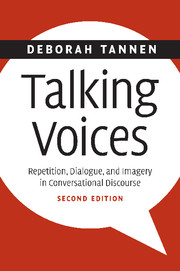Book contents
- Frontmatter
- Contents
- Acknowledgments
- 1 Introduction to first edition
- Introduction to second edition
- 2 Involvement in discourse
- 3 Repetition in conversation: toward a poetics of talk
- 4 “Oh talking voice that is so sweet”: constructing dialogue in conversation
- 5 Imagining worlds: imagery and detail in conversation and other genres
- 6 Involvement strategies in consort: literary nonfiction and political oratory
- 7 Afterword: toward a humanistic linguistics
- Appendix I: Sources of examples
- Appendix II: Transcription conventions
- Notes
- List of references
- Author index
- Subject index
6 - Involvement strategies in consort: literary nonfiction and political oratory
Published online by Cambridge University Press: 23 December 2009
- Frontmatter
- Contents
- Acknowledgments
- 1 Introduction to first edition
- Introduction to second edition
- 2 Involvement in discourse
- 3 Repetition in conversation: toward a poetics of talk
- 4 “Oh talking voice that is so sweet”: constructing dialogue in conversation
- 5 Imagining worlds: imagery and detail in conversation and other genres
- 6 Involvement strategies in consort: literary nonfiction and political oratory
- 7 Afterword: toward a humanistic linguistics
- Appendix I: Sources of examples
- Appendix II: Transcription conventions
- Notes
- List of references
- Author index
- Subject index
Summary
Each of the preceding three chapters focuses on a single involvement strategy. In this chapter, I show how the three strategies examined: repetition, constructed dialogue, and details and imagery,work together with each other and with other strategies to create involvement. Furthermore, there has been a movement, within each chapter and across the chapters, from conversation to more deliberately composed genres, both written and spoken discourse types that combine involvement strategies in a variety of ways. This chapter is concerned exclusively with nonconversational genres. It analyzes, first, an example of academic writing that uses involvement strategies more commonly found in fiction, and then examines in detail a formal spoken genre: a political speech modeled on the African-American sermon. Throughout, I emphasize again the inseparability of emotion and thought.
Thinking with feeling
In her memoir of her parents, Margaret Mead and Gregory Bateson, Mary Catherine Bateson (1984) returns repeatedly to the inseparability of emotion and cognition. She notes that Gregory Bateson “genuinely rejected the notion of a separation between thought and feeling” (173). Similarly, Mead's “prose echoes with the lines of memorized poetry” and with gospel (for example, “with references to women ‘great with child’ rather than pregnant”). Mead used such “evocative language,” Bateson observes, “to make it possible for readers to respond emotionally as well as intellectually” (200–1).
The conviction that no discourse could, or should try to, be emotion-free became crucial to Mary Catherine Bateson when she confronted the task of communicating ideas that evolved in scholarly interaction.
- Type
- Chapter
- Information
- Talking VoicesRepetition, Dialogue, and Imagery in Conversational Discourse, pp. 161 - 186Publisher: Cambridge University PressPrint publication year: 2007

